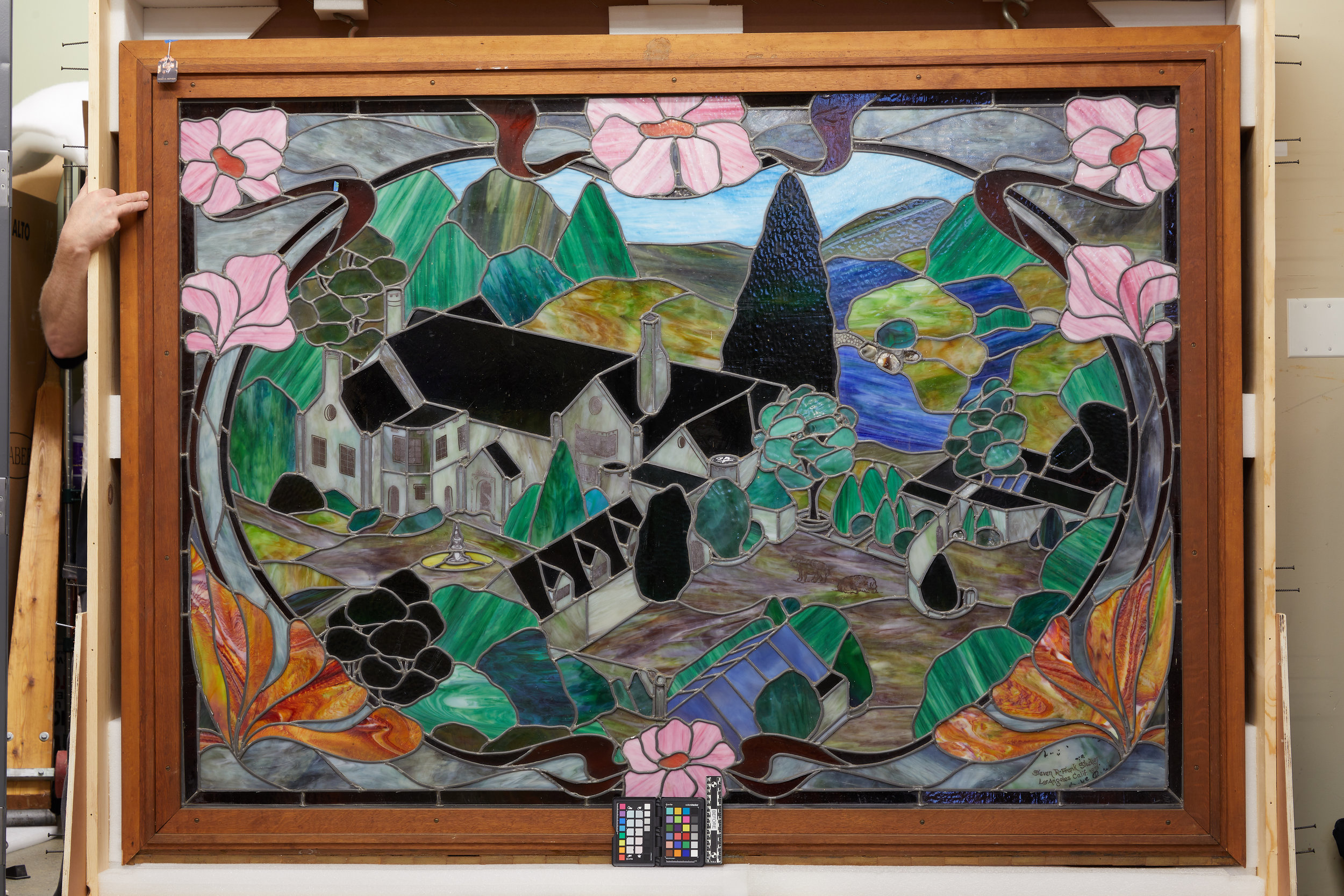“Stained glass” to most brings up something antique and spiritual: memorials, landscapes, anything delicate and expensive. When the giantess that is the glass panel depicting Hugh Hefner’s Playboy Mansion in Los Angeles arrived at The Conservation Center, it was something that none of us – least of all its owner – had seen before.
The stained-glass panel before treatment.
Fresh from Julien’s Auctions in Los Angeles, the piece – 5’ x 7’ and 350 pounds – was the first item our client had purchased at auction, and certainly not a bid he expected to be successful. The auction consisted of 825 lots over two days and attracted our client, who mostly collects Outsider Art, out of curiosity. The work is not only the largest in his collection, but also his first acquisition by a West Coast artist. “I was intrigued by the scope and scale of the glass panel,” he said, “I was also attracted to its storied history and that it was commissioned in 1975 from Steven Frank Studios in Los Angeles.” The panel features the Playboy Mansion, Hefner’s estate, surrounded by vibrant flowers and a lush landscape, swimming in fairytale – like colors.
A closeup of the inscription, “Love Barbi” at the bottom.
Its commissioner was of some importance, as well – Barbi Benton, a model, actress, and singer in her own right, was credited with convincing Hefner to buy the Playboy Mansion and gave this to him a few years after he moved to Los Angeles full time. Her gift hung behind the game house at the Playboy Mansion, and even briefly appeared in a scene from The Girls Next Door.
The piece arrived still bearing the lot tag from the estate auction.
The stained glass panel at home in the Playboy Mansion, photo courtesy of Julien’s Auctions.
Hugh Hefner’s daughter, Christie Hefner, a well-respected business leader and a strong advocate for the advancement of women and social justice, speaks fondly of her father’s self – made utopia. “When my dad bought Playboy Mansion West for a little over $1 million in 1971, it was the highest price ever paid in Los Angeles for a residential property. 45 years later it set another record, selling for $100 million. Hef always felt that this was Shangri La, and indeed the 5 acre setting, including the largest redwood forest in Southern California, made you feel like you were miles away from a city, even though it was only a block off of Sunset Blvd.”
Hefner himself was a patron of the arts, launching many careers and paying his artists at the publishing house top dollar. The cartoon scrapbooks he kept in his youth paved the way for his interest in publishing, eventually making him the media mogul we recognize. The magazine’s wide reach and prestige continually brought in the best talent to work for it, carrying in tides of the biggest names in cartoons – like Al Jaffee, Arnold Roth, and Shel Silverstein. Art Paul, his head designer for years and creator of the iconic rabbit head design, gave tutelage to Dali, Warhol, Paschke, and Roger Brown, among others.
As you could expect from a collector, the panel had been well cared for during its time at the Mansion. Our conservator Sian Pirnie in our Objects and Gilding department maintained that the piece was in remarkably good shape, having been outside for the better part of 40 years.
Straight from the auction to The Center, this glass panel took several hands to unpack. Due to its size, it had to remain upright during treatment, otherwise it would be crushed by its own weight. The glass panel began its treatment by getting photographed for in-house documentation. Then, Sian consolidated cracks and lifting metal with conservation-grade epoxy and resin. The glass was swab cleaned with deionized water and non-ionic detergent, and the lower part of the frame was reattached. The entire treatment took almost a week to complete.
Objects conservator Sian swab cleans the glass panel during treatment.
Though most are familiar with well known glass studios, like Tiffany or Chihuly, Steven Frank Studios was much harder to find. Mark Tuna, currently the owner of Glass Visions Studio and former employee of Steven Frank Studio, reasons that he might be the only alumnae still working. He began his career at the studio at the age of 14, apprenticing after school. When Steven Frank Studios closed, Mark was only 19 – it was 1975, and the Hugh Hefner stained glass was one of the last pieces he worked on. Mark went on to open his own shop and is still enjoying an illustrious career in glass.
The panel after receiving treatment.
So what’s next for this oversized glass? Its new owner isn’t sure. “I would be delighted to find a way to display it to a wide audience and I’ll be looking to put the glass panel out for public enjoyment as often as I can,” he says. In the meantime, he’s pleased with the results of the treatment: “I feel like the luckiest guy in town being the owner of the finely restored art glass panel. I am grateful to Heather Becker and The Conservation Center for providing a careful and lasting restoration.”
Christie agrees: “We were excited that Hef chose to leave his personal possessions to the HMH Foundation so that the auction proceeds could further the mission of the Foundation to work for freedom of expression. We are grateful to the collectors who bid generously as well as their willingness to share these unique cultural icons with others. In a similar vein to this collector, the owner of Hef’s 1960’s typewriter has lent it, with a dozen others, to the Chicago based American Writers Museum where it is now on display. I used to say that there were two homes in the U.S. that everybody wanted to visit: The White House and The Playboy Mansion, and not necessarily in that order.”







